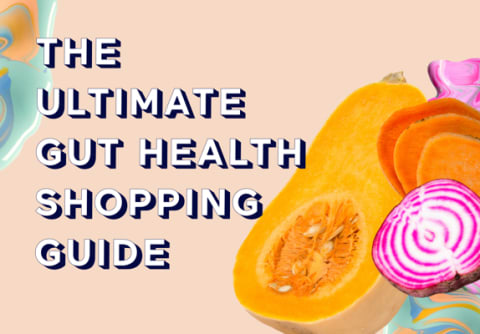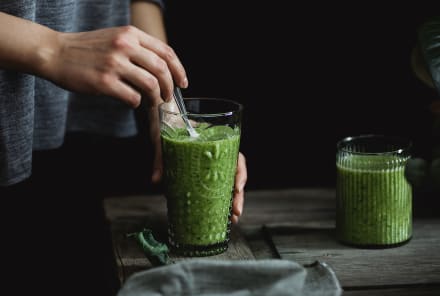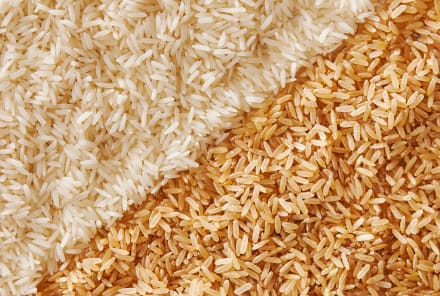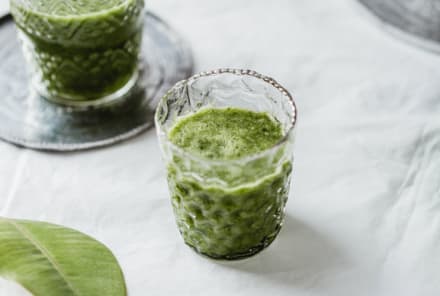Advertisement
Common Nutrient Deficiencies In The Vegan Diet & How To Fix Them

Vegetarian and vegan are a great way to eat more plant-based, add more greens to your diet, and ease your load on the planet. But diets done wrong can lack nutrients and fuel inflammation. Let's take a closer look to avoid these common plant-based pitfalls.
Vegan diets can rely too heavily on carbs.
Many vegans and vegetarians have been led to believe that "healthy" carbs are what we need for sustainable energy. This belief causes one of the biggest problems with a conventional plant-based diet.
But a report in the 1American Journal of Clinical Nutrition1 explains1 how we've seen a rapid change in our world over a relatively short period of time. Our current food supply, soil depletion, and environmental toxins have all been new introductions to human existence. Put another way, around 99 percent of our genes were formed before the development of agriculture and the consumption of grains like wheat, around 10,000 years ago.
Researchers now argue that these factors are essentially a mismatch with our genes. And more recent refining, hybridization, spraying, and genetic modification of the grain supply have likely only made things worse. Our genes are living in a whole new world.
Bottom line: Grains (and a lot of other foods) are not what they once were. And in our modern, toxic world, we have less wiggle room for unhealthy foods than generations before us did. It's just a matter of someone's own genetic interaction with grain, especially gluten-containing grains, that determines if, when, and how a health problem will be triggered.
When we consume too high amounts of processed grains, we quickly start to raise our blood sugar, which over time can get out of control without us even realizing it. These refined grains are also high in sugars. These grain sugars overwhelm your body, causing insulin spikes and a hormonal hurricane of insulin resistance, high triglycerides, and inflammation—hallmarks of chronic disease.
Grains are also high in a class of sugars called FODMAPs. This funny-sounding acronym stands for fermentable oligosaccharides, disaccharides, monosaccharides, and polyols—in other words, fermentable sugars. These short-chain sugars are not fully digested in your gut and can be excessively fermented by your gut bacteria. This fermentation releases hydrogen gas that causes distention of the intestines—which can cause major IBS and small intestinal bacterial overgrowth (SIBO), with symptoms like pain, gas, bloating, constipation, and diarrhea.
Vegan diets can affect gluten sensitivities.
With grains, though, it's not just about the sugars like the FODMAPs; it's also about the proteins. Researchers estimate that around 18 million Americans have a "gluten sensitivity." The growing awareness of gluten, the protein found in grains such as wheat, rye, barley, and spelt, has spawned an endless vortex of gluten-free everything.
What's the bottom line? Is gluten something you should avoid, or is it an overblown fad reminiscent of the "fat-free" movement that had little to no health merit? Is gluten intolerance actually real?
One trial published in 2Clinical Gastroenterology and Hepatology2 studied people who thought gluten was causing them digestive problems. The gold standard for research is a randomized, double-blind, placebo-controlled, crossover trial, and this study checked all the boxes. For one week participants were given either a small amount of gluten or a placebo pill of rice starch. After only one week, those who were taking the gluten pills reported a significant increase in symptoms compared to those who took gluten-free placebo pills. Other randomized control trials have shared similar findings3.
To understand gluten intolerance, we need to understand autoimmune conditions. Many people think when we talk about gluten intolerance we are referring to the autoimmune condition celiac disease. Celiac disease is really the extreme end of a broader gluten-intolerance spectrum. The other end of that spectrum is nonceliac gluten sensitivity (NCGS)4.
- Abdominal bloating
- Ulcers
- Intestinal pain
Because your gut is your "second brain," people with gluten intolerance can also experience the following:
- Brain fog
- Depression
- Anxiety
- Fatigue
What most people don't realize is that your body could be reacting to more than 20 different aspects of wheat. Most patients who ask to be tested for gluten intolerance get a simple alpha-gliadin lab test. If it comes back negative, you are told you are not gluten intolerant. You may want to then celebrate the good news by eating a basket of breadsticks, but not so fast. Alpha-gliadin and the common celiac lab test for transglutaminase 2 are just two pieces of about a 20-piece wheat puzzle.
Vegan diets can be high in lectins and phytates.
Lectins are another type of protein found in grains, even the gluten-free ones like rice and corn. These grain defense mechanisms are highly indigestible by the body. When your gut is damaged by this mild toxin, your body's defense systems are compromised, causing inflammation6. Lectins can also bind to insulin and leptin receptor sites, causing hormonal resistance patterns such as weight-loss resistance.
If you haven't already found yourself emptying your cupboards, then we can talk about phytates. Grains also contain these nutrient leeches. Phytates7 are anti-nutrients that bind to minerals in your body and make them unusable. The little nutrients that grains do offer are diminished by phytates, which make them unavailable for your body. Therefore, it doesn't really matter how many nutrient-dense vegetables you are having if you end up counteracting their benefits.
It's important to remember that grains today are not what they were in the past. With crossbreeding and genetic modification, grains are chemically different today than they were even a few decades ago. A common argument for eating grains is to get in an adequate amount of fiber. However, vegetables offer ample amounts of fiber8—not to mention a whole slew of other nutrients8.
Another primary food in typical plant-based diet is legumes. This category encompasses all types of beans, lentils, and peanuts. Because of their protein content, they have become a typical stand-in for meat in many vegetarian and vegan lifestyles. The problem here is that lectins and phytates are also found in legumes in high amounts, similar to grains.
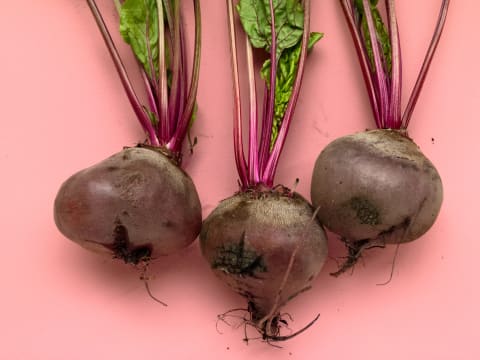
Vegan diets can cause nutrient deficiencies.
If you are filling your plate with more grains and legumes rather than fresh vegetables, you are probably going to run into some health problems sooner or later. But we can even see the lack of nutrients play out in many plant-based diets that don't rely heavily on those two food groups.
Many studies link vegetarian and vegan diets to deficiencies in key nutrients including vitamin D, magnesium, B vitamins, and iodine9—all nutrients that if lacking can lead to hormonal, thyroid, and methylation impairments. Many of these nutrients are available only in animal sources, and the ones that are found in plant sources do not have the same level of bioavailability10. And the sources that do have decent nutrient levels also contain phytates, which end up blocking nutrient absorption.
For the most part, while vegetarian and vegan diets can both lead to major nutrient deficiencies, you typically see this less in vegetarians than in vegans because they usually still eat some type of animal product such as eggs. Either way, let's take a deeper look at the most common deficiencies and why plant-based diets don't always make the cut in this department.
DHA and EPA
Omega fatty acid deficiencies11 in the standard vegan diet are the subject of a long-held argument. But if you are feeling better from not eating meat, is it that important to worry about not getting these omega fatty acids? A well-balanced diet with natural sources of alphalinolenic acid (ALA) and the long-chain omega-3 fatty acids DHA and EPA11 is fundamental to maintaining a healthy ratio that prevents inflammation and promotes long-term health by protecting against health problems like autoimmune and cardiovascular disease. Additionally, your brain is composed of about 60 percent fat, so depriving your body of fat can contribute to all kinds of unpleasant brain symptoms, from brain fog and fatigue to depression and anxiety12. In other words, healthy fat is essential for optimal brain health.
It is vital to consume these fatty acids because they can't be synthesized by the body, and diet is the only way to get them in. Before you argue that plant-based dieters can get these omega fats through plant-based sources such as legumes, nuts, and seeds, let's talk about how bioavailable these sources actually are.
The average American consumes a large amount of their omega-3s in the form of ALA. These are derived from plant sources. ALA is an energy source for our cells, and a small percentage of this is converted into DHA and EPA. In fact, only up to 10 percent of EPA and up to 5 percent of DHA actually end up being converted in the body13. The amplest amounts are found in fatty, cold-water fish sources such as salmon, trout, cod liver, herring, mackerel, and sardines, and in shellfish such as shrimp, oysters, clams, and scallops. These sources of omega-3 14are the most bioavailable to your body. Vegetarians have an estimated 30 percent deficiency in both EPA and DHA; vegans have a 50 percent deficiency in EPA and a 60 percent deficiency in DHA.
With ALA being a large source of our omega-3 consumption, and the only source for vegans, it is vital to consume DHA and EPA sources. And yes, that may mean incorporating some fish or at least algae like spirulina (which also contains bioavailable omegas15) into your diet.
Vitamins A and D
Fat-soluble vitamins, in particular, are some of the worst deficiencies that we see in vegans and vegetarians. This is because these two vitamins are almost exclusively found in animal-based foods16 such as organ meats, eggs, dairy fats like ghee, and wild-caught seafood.
No other vitamin can hold a candle to vitamin D when it comes to importance and influence on health. Since vitamin D is fat-soluble, it acts more like a hormone than a vitamin by regulating thousands of vital pathways in your body. Besides your thyroid hormones, this vitamin is the only other thing every single cell of your body needs in order to function properly17. Also known as the sunshine vitamin, vitamin D is synthesized by your body when your bare skin is exposed to sunlight. But it is impossible to get enough vitamin D from food alone, and unless you live in a very sunny place (closer to the equator) and are outside frequently without sunscreen or tons of clothing, you are probably deficient.
Since vitamin D deficiency is already a problem for most of the population, omnivores included, it is even greater for plant-based dieters. Typically, vegetarians and vegans, on average, have more vitamin D deficiencies compared to meat eaters18.
Vitamin A is essential for a strong immune system, and vitamin A deficiency has been linked to autoimmune diseases19, which are on the rise in a major way. Some researchers believe this has to do with our dendritic cells, which are our alarm cells of the immune system that can send out a "red alert" to stimulate immunity or a "calm down" message that tones down excessive immune reactions that can damage the body. The "calm down" message uses vitamin A.
Plant beta-carotenes, a precursor to vitamin A, are found in sweet potatoes and carrots, but the conversion rate to the usable form of vitamin A, retinol, is very weak. In fact, research suggests that just 3 percent of beta-carotene gets converted in a healthy adult20. Because of this, you can see how deficiency can be common among people who eat a vegan or vegetarian diet. You'd have to eat a rather large amount of carrots and sweet potatoes to even attempt to reach adequate levels.
B12
This is potentially the biggest deficiency for all types of plant-based diets. B12 is absolutely necessary for methylation21, which happens more than 1 billion times a second in your body to keep you alive and healthy. It is your DNA protection system; it controls how efficiently you detox, and every single cell of your body depends on this process. In short, if methylation is not working well, a lot can go wrong with your health.
True B12 is found only in animal products such as wild-caught fish, grass-fed beef, eggs, and dairy products22. A common alternative of plant-based B12 often comes from sea vegetables like seaweed and spirulina as well as fermented soy. However, these don't contain true B12. Instead, they are B12 analogues known as cobamides, which are not as bioavailable23.
For vegan and vegetarian dieters, this is one nutrient that no matter what or how much you choose to eat, you'll never truly be able to reach optimal levels without supplementation. In fact, it's estimated that 68 percent of vegetarians and 83 percent of vegans24 are deficient in this vital vitamin.
And that's not taking into account any possible genetic weaknesses. A mutation in your MTR/MTRR methylation gene25, which regulates B12 production, can require higher intakes of B12 than normal since the body ends up using B12 faster than it can produce it.
Zinc
Your body has no significant way to store this important mineral, so it's important to make sure you're getting it through your diet or supplementation. Zinc's main role is to help your body increase white blood cells and fight off infection26, and it also assists with the release of antibodies. Deficiency has been linked to increased instances of illness,27 so it's no wonder you often find zinc as a common ingredient in the cold and flu aisle of your pharmacy. It can also be especially important for pregnant women and the reduction of preterm births. 28
This is a very easy nutrient to get through a plant-based diet. But what we often see is that typical plant foods that contain zinc still contain phytates, which block nutrient absorption. So if intake is not monitored, zinc deficiency can still happen and often requires more zinc-containing foods to reach necessary daily intake levels.
Iron
Iron is needed to get oxygen to your cells. And if your cells are deprived of oxygen, they don't function properly and well, and not much else in your body does either. Some typical symptoms I see with low iron are fatigue and low sex drive29.
There are two ways to look at iron levels in your body. One is serum iron, which measures the levels of iron currently circulating in your blood. The other is ferritin, which measures long-term iron storage in the body. The serum levels of most vegetarians and vegans are similar to those of meat eaters, but the difference is seen when it comes to ferritin levels.
While we definitely don't want ferritin levels to be too high, which is correlated with increased inflammation30, we don't want them to be low either, which is a sign of iron deficiency.
There are also two different types of iron—heme and non-heme. Heme is the most bioavailable iron for your body and is found only in meat. Non-heme isn't absorbed as easily and is found in dairy, eggs, and plant foods.
Many plant foods contain iron but only the non-heme variety. Dark leafy greens, mushrooms, nuts and seeds, and legumes all contain high amounts of iron, but if you are consuming too many legumes, you'll run across problems with phytates decreasing your absorption. Additionally, iron absorption can be inhibited by other substances that are consumed such as calcium, coffee, and tea. And again, plant sources just do not have the same level of bioavailability as animal sources. All of these factors contribute to an 85 percent lower non-heme iron absorption rate in plant-based diets.
As our deficiencies continue to escalate, so does our need to supplement. For vegans and vegetarians, all of these deficiencies can be mitigated through regimented supplementation—but only if you're aware of the problems in the first place.
30 Sources
- https://academic.oup.com/ajcn/article/81/2/341/4607411
- https://www.ncbi.nlm.nih.gov/pubmed/25701700
- https://www.ncbi.nlm.nih.gov/pmc/articles/PMC4772047/
- https://www.ncbi.nlm.nih.gov/pmc/articles/PMC4488826/
- https://www.ncbi.nlm.nih.gov/pmc/articles/PMC6182669/
- https://www.ncbi.nlm.nih.gov/pmc/articles/PMC433288/
- https://www.ncbi.nlm.nih.gov/pmc/articles/PMC2266880/
- https://www.ncbi.nlm.nih.gov/pmc/articles/PMC3649719/
- https://www.ncbi.nlm.nih.gov/pmc/articles/PMC5598028/
- https://www.ncbi.nlm.nih.gov/pmc/articles/PMC3651966/
- https://www.ncbi.nlm.nih.gov/pmc/articles/PMC5705809/
- https://www.ncbi.nlm.nih.gov/pubmed/21436600
- https://www.ncbi.nlm.nih.gov/pubmed/12936959
- https://www.cambridge.org/core/services/aop-cambridge-core/content/view/0C287B125293EF075DFF6169154201A6/S0007114512001456a.pdf/dietary_sources_of_omega_3_fatty_acids_public_health_risks_and_benefits.pdf
- https://www.ncbi.nlm.nih.gov/pmc/articles/PMC5387034/
- https://www.ncbi.nlm.nih.gov/pmc/articles/PMC4810759/
- https://ods.od.nih.gov/factsheets/VitaminD-HealthProfessional/
- https://www.ncbi.nlm.nih.gov/pubmed/21139125
- https://www.ncbi.nlm.nih.gov/pubmed/20655952
- https://www.ncbi.nlm.nih.gov/pubmed/12001013
- https://www.ncbi.nlm.nih.gov/pmc/articles/PMC4644301/
- https://ods.od.nih.gov/factsheets/VitaminB12-HealthProfessional/
- https://www.ncbi.nlm.nih.gov/pmc/articles/PMC4042564/#!po=55.8824
- https://www.ncbi.nlm.nih.gov/pubmed/12816782
- https://www.sciencedirect.com/science/article/pii/S0149763414002048
- https://www.ncbi.nlm.nih.gov/pmc/articles/PMC2277319/
- https://www.ncbi.nlm.nih.gov/pmc/articles/PMC3649098/
- https://www.ncbi.nlm.nih.gov/pmc/articles/PMC3787719/
- https://www.ncbi.nlm.nih.gov/pmc/articles/PMC6283628/
- https://www.ncbi.nlm.nih.gov/pmc/articles/PMC5223018/
Watch Next
Enjoy some of our favorite clips from classes
Enjoy some of our favorite clips from classes
What Is Meditation?
Mindfulness/Spirituality | Light Watkins
Box Breathing
Mindfulness/Spirituality | Gwen Dittmar
What Breathwork Can Address
Mindfulness/Spirituality | Gwen Dittmar
The 8 Limbs of Yoga - What is Asana?
Yoga | Caley Alyssa
Two Standing Postures to Open Up Tight Hips
Yoga | Caley Alyssa
How Plants Can Optimize Athletic Performance
Nutrition | Rich Roll
What to Eat Before a Workout
Nutrition | Rich Roll
How Ayurveda Helps Us Navigate Modern Life
Nutrition | Sahara Rose
Messages About Love & Relationships
Love & Relationships | Esther Perel
Love Languages
Love & Relationships | Esther Perel
